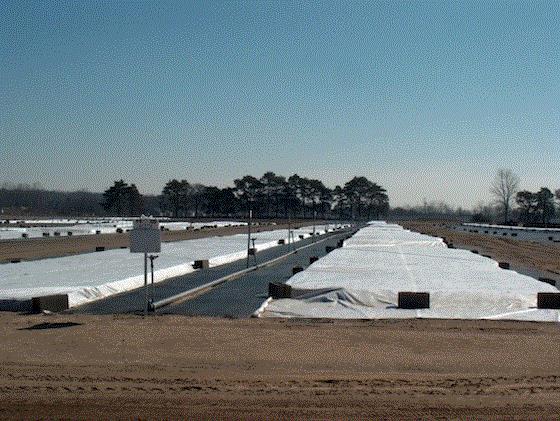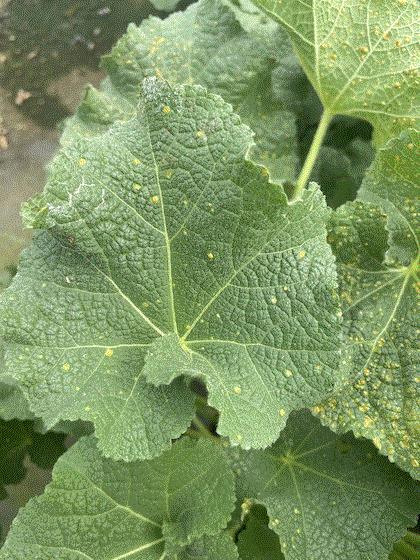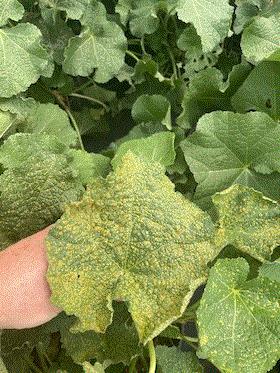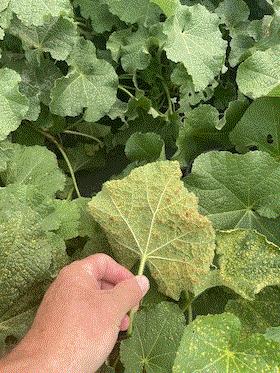What’s Happening Here?
I’m starting this week’s challenge off with a diagnostic challenge for you to ponder as you enjoy this week’s newsletter. I think it’s fairly easy, but I’ll let you be the judge of that. Check it out:
I saw this peculiar-looking leaf spotting on a few alcea plants back in August. Without totally giving the answer away, I can tell you that it’s a fairly common problem on hollyhocks.
Did I say too much already or have I left you filled with uncertainty? Are these spots caused by a disease, insect feeding, phytotoxicity or something else? As they say, time will tell. I know that for certain in this instance as I’m revealing the answer below.
It’s time for me to ask, “What’s Happening Here?”
Win a FREE Yeti!

I thought that subject line might grab your attention. Before I get to the details on the Yeti, I wanted to invite you to participate in the 27th Annual GrowerTalks and the 14th Annual Green Profit Wage & Benefit Surveys.
Do you offer benefits? Do you pay your staff? Do you know how your wages and benefits package stack up compared to others in your state or from across the nation? Then the 2022 Wage & Benefit Surveys from GrowerTalks/Green Profit are a must for you to fill out.
If you’re a grower, retailer or even a combo of the two, you’ll be helping out yourself and your colleagues by answering the following surveys:
For growers, find the survey HERE.
For retailers, find the survey HERE.
As an incentive for filling out the survey, you’ll be entered into a random drawing to win a Yeti Tundra 45 Hard Cooler (a $325 value!). The deadline to fill out the survey is October 28, 2022.
(Please note that if you’re a grower-retailer, please fill out both surveys. That’ll double your chance to win the cooler!)
The results will appear in the December issue of GrowerTalks and the January issue of Green Profit.
Remember, the deadline for the surveys is October 28, 2022. Thank you in advance for your participation and good luck with the Yeti drawing.

Echinacea Sunseekers Tequila Sunrise

Not to be confused with the colorful and tasty cocktail, Tequila Sunrise is an eye-catching bicolored echinacea. It’s a relatively new addition to the popular and reliable Sunseekers series from
Green Trade Horticulture.
This well-branched echinacea develops golden yellow flowers with reddish-pink colors at the base of the petals surrounding attractive orange brown central cones.
When I’ve grown them, the flower petals appear more orange than yellow. Either coloration results in beautiful eye-catching flower displays. It grows up to 24-in. tall, is hardy to Zone 3 and has all the other great attributes your expect from echinacea.
3½ Steps to Overwintering Perennials

Protective blankets on perenials being overwintered outside.
Here’s a reminder of the upcoming overwintering webinar I previously mentioned. If you take on the risks associated with overwintering perennials, I encourage you to attend this timely and informative webinar.
Overwintering perennials is as easy as 1, 2, 3 (and a half). Come join Darwin Perennials’ Perennial Product Representative Chris Fifo at 1:00 p.m. Eastern/12:00 p.m. Central on Thursday, October 27, 2022 for a FREE webinar where Chris will provide information on how you can successfully overwinter perennials. In this webinar, Chris will cover:
-
How to choose the right varieties
-
How to choose the right structure
-
Proper culture and growing techniques
Click
HERE for this timely FREE webinar.
Sponsored by Darwin Perennials.
The Answer is …

I presented you with a diagnostic challenge at the beginning of the newsletter. Were you able to think about the potential cause(s) of the leaf spots on the alcea shown above? Below are images showing a leaf with more leaf spotting than the first picture I showed you.
|
 Upper leaf surface Upper leaf surface
|

Lower leaf surface
|
Still uncertain? If you recall, one of the diagnostic steps to do when diagnosing leaf spots is to look at the undersides of the leaves. The images above show the upper and lower leaf surfaces of the same leaf.
Consider asking yourself a series of questions to narrow down the cause of the spots: Are the leaf spots only on the upper leaf surfaces or are they on both sides? Are the spots sunken, raised or flat? Are they occurring on new leaves or on the older ones? How many plants are showing these symptoms: a single plant, several plants adjacent to one another or are they observed throughout the crop? Even when you think you know what’s causing a problem on crops, asking yourself questions such as these is so valuable to determining what they are.
Okay, let’s get back to the challenge. As you can see, the leaf spots are on both sides of the leaves and the spots on the undersides are directly below the spots on the upper leaf surface. The lower spots protrude or are raised (appear bumpy). This information combined with the images above should be enough to solve the challenge.
If you guessed rust, congratulations! You nailed this week’s challenge.

P. malvacearum 101
Here’s a brief overview of alcea rust.
Rust (Puccinia malvacearum) is a fairly common fungal disease observed on alcea. Fun fact: Rust diseases are specific to the plant or family of plants they're attacking. For example, the rust that attacks alcea is different from the one that infests aster.
The bumpy, blister-like appearance on the undersides of the leaves are actually pustules from the fungal disease. Spores of rust are spread by air currents from wind or fans from heating and cooling systems or they can be dispersed by splashing water. They germinate on leaves that are wet and when temperatures are between 50 and 75F. Spores generally require three to six hours of leaf wetness for them to germinate. Rust infections are also likely to arise in areas where nightly dew formation occurs (warm days and cool nights).
Although rust doesn’t kill the plant, it does reduce plant health, vigor and aesthetic appearance/marketability. After the spores germinate and infect the plant, the disease can lie dormant in the green tissues until optimal conditions arise for sporulation. This is a systemic disease and may not exhibit symptoms on the plant. From personal experience, trimming infected leaves may help in the short run, but I’ve often seen this disease reappear on previously infected plants in the long run.
The good news is rust can be prevented fairly easily. First, try reducing the duration the foliage remains wet following overhead irrigation. Avoid overhead irrigating crops in the evenings or at night; instead water susceptible plants such as alcea in the mid-morning. This allows the foliage to dry quickly.
Secondly, the occurrence of rust can nearly be eliminated when preventative fungicide applications are applied. Several fungicides including those products containing the active ingredients azoxystrobin, chlorothalonil, mancozeb, myclobutanil, propiconazole, pyraclostrobin, pyraclostrobin + boscalid, triadimefon, and triflumizole are effective at controlling ornamental rust diseases. It’s beneficial to apply preventative applications just prior to conditions conducive to this disease developing or immediately after rust has been detected.




Thanks for reading this edition of Perennial Pulse. My email is paul@opelgrowers.com if you have any comments, article suggestions or if you'd just like to say hello.
Paul Pilon
Editor-at-Large—Perennial Pulse
Director of Growing—Opel Growers
This email was received by you and 34,755 other fine subscribers!
If you're interested in advertising in Perennial Pulse, contact Kim Brown ASAP and she'll hook you up.